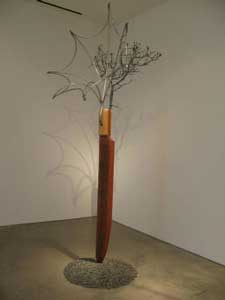James Surls’ sculptures dazzle
by Douglas Britt, Houston Chronicle

James Surls' Standing Knife, Pinon, and Morning Glory, 2009
James Surls is having a busy year. A giant of Texas art even since moving to Carbondale, Colo., in 1997, Surls has a solo exhibition of recent sculpture and drawings on view through Aug. 22 at the Grace Museum in Abilene. The museum also published a generously scaled catalog of the same title as the exhibit, James Surls: From the Heartland.
From March until late July, the New York City Parks Public Art Program had seven of Surls’ large bronze and stainless-steel flower- and treelike sculptures installed at regular intervals along Park Avenue.
And on Aug. 27, he’ll help the Lawndale Art Center, which he founded during his time as a University of Houston professor, celebrate its 30th anniversary.
Sometimes when an artist has so much going on, a gallery show can feel superfluous from a viewer’s standpoint, if understandable from a commercial one — a chance for the gallery to cash in on synergy by presenting leftovers in conjunction with all the hullabaloo. A sideshow to the main attractions.
Not so James Surls: From 2009 at Barbara Davis Gallery. The sculptures and drawings on view look like they were made by an artist with nothing on his mind but the work at hand and the inspirations behind it.
Such sources likely include nature first and foremost, but also what Patterson Sims describes in the Grace Museum catalog as Surls’ “studies (of) myths, science and human behavior … (and an) almost obsessive reading and writing of Romantic poetry (that) sustains him.”
I have to take my hat off to Sims and the other catalog contributors for showing how much there is to say about Surls’ work, which, unlike some artists’ output, doesn’t provoke me to talk up a storm. To the contrary, it makes me want to just sit with it quietly.
The silence it inspires might be awestruck on the one hand, especially in the face of what strikes me as a masterpiece, the hanging sculpture Me, With Two Flowers and the Stones Face, in which a pair of Surls’ familiar floral forms are balanced with a chunk of beautifully layered stone that rests as if on a hook, as a beautifully carved wooden appendage — a tusk? something phallic? — dangles below.
Ditto a steel piece like All About Three, which showcases Surls’ brilliance as a welder, or the virtuosity of Standing Knife, Piñon, and Morning Glory. More than 10 feet tall, it brings to life a mahogany knife whose tip stands in a circular bed of rocks. The flowering plant and piñon tree — one steel, one brass — bloom from the opposite end of the knife, and the whole thing is both weighty and lighter than air.
Yet those same pieces and others prompt different kinds of silence, too — the silence you sometimes assume around friends who know you better than you know yourself, or when hiking in the mountains, perhaps the kind near the studio where these magnificent works were made.
